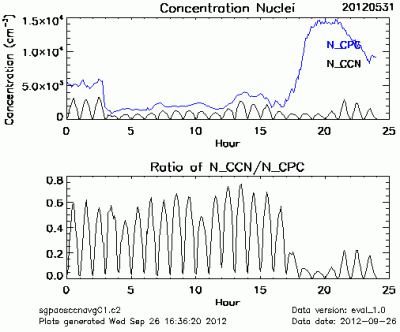Surface Cloud Condensation Nuclei Average Evaluation Product Available
Published: 9 October 2012

The %ss of the instrument is stepped through 7 intervals every 30 minutes with measurements taken for 5 minutes at each setting in a pyramid profile. The first minute after a change in %ss, the CCN temperatures are unstable and the %ss value usually overshoots the set point value. For this reason the VAP disregards the first minute of every %ss setting, and only averages the last four minutes together.
In the CCN datastream, the %ss is calculated using a heat transfer and fluid dynamics model flow model. To calculate the %ss, the model uses the calibrated temperature, pressure, and flows in the instrument. Small variations in the %ss arise from changes in the column thermal properties in the instrument. The calculated %ss value was chosen to be more reliable than the static calibration obtained via salt aerosol because the %ss value changes dynamically with the instrument flow, pressure and room temperature, and because salt calibrations are inconvenient at remote locations, and therefore, happen infrequently.
Currently, surface CCN average evaluation data are available for the Southern Great Plains Central Facility and the ARM Mobile Facility deployment at Ganges Valley, India. More information on AOSCCNAVG is available at the VAP web page and in the README file that accompanies the data files in the Data Archive’s evaluation area. Please send your feedback to Yan Shi. Feedback will assist in improving the product prior to its full release.
To access these data, log in to the Data Archive. (Go here to request an account.)
The ARM Climate Research Facility is a DOE Office of Science user facility. The ARM Facility is operated by nine DOE national laboratories, including .
Keep up with the Atmospheric Observer
Updates on ARM news, events, and opportunities delivered to your inbox
ARM User Profile
ARM welcomes users from all institutions and nations. A free ARM user account is needed to access ARM data.


















